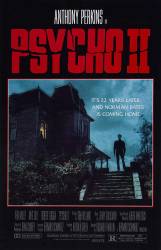Visible crew/equipment: When Dr. Raymond leaves with Mary in his car after talking to Norman, when he drives off the entire crew and equipment can be seen reflected in the side of his car. (00:41:50)

Psycho II (1983)
Directed by: Richard Franklin
Starring: Robert Loggia, Anthony Perkins, Vera Miles, Meg Tilly
Continuity mistake: After Norman argues with Mr Toomey, before he goes up to the house, you can plainly see the light on in the living room where Mary is sitting. When Norman goes in the house, Mary is sitting in the dark and Norman then turns on the light.
Revealing mistake: At the end when Norman is being stabbed at by Mary dressed up as Mother, Mary stabs Norman in the hand. You can plainly tell that this hand is a doll, as it is not a natural colour, it is stiff and is stationary, unlike Norman who is moving his hands. (01:35:10)
Trivia: When Mary and Norman go into Mother's room, before Mary turns on the light look at the shadow on the wall on the right. It is a silhouette of Alfred Hitchcock, the director of the original "Psycho" (1960). (00:24:10)
Trivia: The reflection of young Norman Bates in the doorknob when he flashes back to his mother's poisoning is Anthony Perkins' son, Oz.
Trivia: For the last murder scene, when Norman brains his mother with a shovel in the kitchen (the only murder Norman actually commits in the entire film), his mother turns into a life-size dummy just before the fatal blow. You notice that she inexplicably leans far forward and bows her head (to hide her face for the dummy transition) just before Norman hammers her. This scene took several days to shoot, to get the transition just perfect, and it is the best practical special effect in the movie.
Mary: You really wanna know what Norman's like?
Warren Toomey: Yeah.
Mary: Better than you'll ever be, fat boy.
Norman Bates: Just, don't let them take me back to the institution.
Norman Bates: I don't kill people anymore.
Question: Spoiler alert: this question gives away much of the first "Psycho" movie. In the original Alfred Hitchcock "Psycho" we witness Norman Bates murdering Janet Leigh/Marion Crane and Martin Balsam/Milton Arbogast, and very narrowly missing killing Vera Miles/Lila Crane. At the end of the movie we discover that Norman Bates had murdered his mother and her lover ten years previously. We are also told that he had killed two female guests at Bates Motel. Norman Bates is therefore guilty of six murders and one attempted murder. In Psycho II we find out that, after his crimes were discovered, Norman Bates was placed in a secure psychiatric institution for the criminally insane. This does seem plausible. But with such a criminal record, would he ever be released from incarceration?
Question: Who was doing the killings before Norman finally snapped?
Chosen answer: The murderer is Emma Spool, Norman's biological mother. She was killing people because she didn't want anybody harming Norman.
Emma was not Norman's biological mother. She was the sister of Norma (and Norman's aunt) and jealous that Mr. Bates chose Norma over her and thought Norman should have been the son she and Mr. Bates were suppose to have. Later, while still mentally ill, she believed Norman was her son and told Norman this.
Emma Spool was, in fact, Norman's biological mother. It was revealed at the end of the movie that she is his real mother and Norma Bates is her sister who adopted Norman and raised him While Emma was institutionalized.
Again, that was just Emma being delusional and/or lying. Tracy Venable tells Norman the truth in Psycho III. Emma was never his mother.
I never knew Emma Spool was Norman's biological mother. In fact, I never heard of Emma Spool. Thanks.
Join the mailing list
Separate from membership, this is to get updates about mistakes in recent releases. Addresses are not passed on to any third party, and are used solely for direct communication from this site. You can unsubscribe at any time.
Check out the mistake & trivia books, on Kindle and in paperback.




Answer: Norman was found "not guilty" by reason of insanity. Therefore, once he is deemed to be no longer a danger to himself, or to others, and is released from the mental institution, there is no crime he can be sent to jail for (i.e. he has no criminal record for the murders). I haven't done enough research to tell you if a serial killer in recent times has ever been found not guilty by reason of insanity and subsequently been released, but there are numerous accounts of people being released from mental institutions after committing murder that are then considered free.
Bishop73